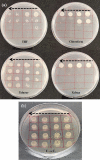Fluorescent polymer as a biosensing tool for the diagnosis of microbial pathogens
- PMID: 38272939
- PMCID: PMC10810778
- DOI: 10.1038/s41598-024-51919-6
Fluorescent polymer as a biosensing tool for the diagnosis of microbial pathogens
Abstract
Diseases and diagnoses are predominant in the human population. Early diagnosis of etiological agents plays a vital role in the treatment of bacterial infections. Existing standard diagnostic platforms are laborious, time-consuming, and require trained personnel and cost-effective procedure, though they are producing promising results. These shortcomings have led to a thirst for rapid diagnostic procedures. Fluorescence-based diagnosis is one of the efficient rapid diagnostic methods that rely on specific and sensitive bacterial detection. Emerging bio-sensing studies on conducting polymers (CPs) are gaining popularity in medical diagnostics due to their promising properties of high fluorescence efficiency, good light stability, and low cytotoxicity. Poly[2-methoxy-5-(2'-ethylhexyloxy)-1,4-phenylenevinylene] (MEH-PPV), is the first identified soluble polymer and model material for understanding the fundamental photophysics of conventional CPs. In this present study, MEH-PPV is used as a fluorescent dye for direct pathogen detection applications by interacting with the microbial cell surface. An optimized concentration of MEH-PPV solution used to confirm the presence of selective bacterial structures. The present study endeavours towards bacterial detection based on the emission from bacteria due to interfacial interaction between polymer and bacterial surface.
© 2024. The Author(s).
Conflict of interest statement
The authors declare no competing interests.
Figures







References
-
- Rodrigues MC, et al. Resistance of filamental fungi in opportunistic mycoses: Literature review. Res. Soc. Dev. 2022 doi: 10.33448/rsd-v11i4.26198. - DOI
MeSH terms
Substances
Grants and funding
LinkOut - more resources
Full Text Sources

